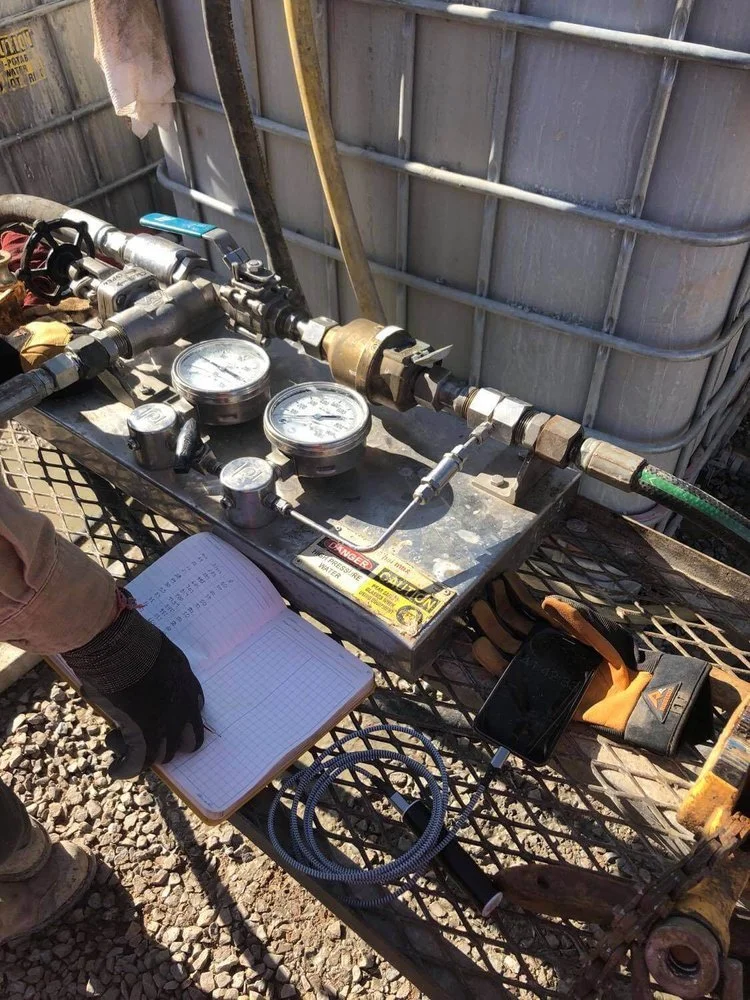Packer Testing Methods and Purposes
Borehole and aquifer testing is an essential part of characterizing the underlying hydrogeological conditions at various project sites in many Lytle Water Solutions projects. The packer test is a widely-used method to determine in-situ (i.e., in place) or localized hydraulic properties of formations, especially in boreholes intersecting various rock units or multiple water-bearing strata within an interbedded formation. Open hole water levels and other forms of testing cannot provide the detailed aquifer hydraulic properties of individual horizons that can result from packer tests.
A packer test isolates specific regions of a borehole using one or more inflatable or mechanical bladders on an apparatus called a packer system. In Photo A, the blue sections enclose the bladder on a single packer assembly. When lowered downhole to the required depth, this type of packer is hydraulically inflated using fluid in drill rods to seal against the edges of the borehole. A section of the borehole is isolated between the packer and the bottom of the hole; thereafter, a test can be performed on the interval. Assembling and operating a packer system requires adequate knowledge and experience to troubleshoot any issues with the equipment or test process. For example, packer leaking or incomplete inflation can result from a misaligned part within the packer system or incompetent rock in the test zone. Testing procedures are standardized in ASTM (American Society for Testing and Materials) documents and establish compliance criteria for properly calibrated equipment and accurate test set-up to ensure data quality.
Packer tests are performed during or after drilling a borehole. If tests are conducted during borehole advancement, one packer can be used to test between the packer and the bottom of the hole as described in Photo A.
Photo A: Packer System
Photo B: Packer System control board
Alternatively, two packers can be used to test if drilling is complete. Two packers allow flexibility in the selection of the test zone. Rods are placed through the inflated packers to inject water into the targeted formation interval. Photo B shows the board of gauges and valves used to control the pressure of water injected into the interval during the test. Pressure and flow rate are recorded during a test and analytical methods (e.g., Thiem equation) are used to determine hydraulic conductivity of the rock and transmissivity of the zone.
Knowledge gained from packer testing can help design the appropriate hydrogeological program to address potential groundwater quantity and/or quality issues. Data derived from packer tests will not only provide insight to the pathways for water and contaminant movement, but also the vertical distribution of water quality. Through the use of packers downhole, water-quality samples can also be collected at isolated intervals.
For proper well placement and construction, water-bearing zones within the borehole should be identified and correlated to the geology across the site. Packer tests can illuminate which formations have the highest transmissivity and best aquifer hydraulic characteristics. Therefore, packer tests not only assist with a better understanding of each specific water-bearing zone and what the relative production potential is, but also whether the zones have desirable or undesirable quality for the uses anticipated.
For more information about aquifer testing and what is required in your particular situation, please reach out to Lytle Water Solutions and we will be happy to provide you a proposal tailored to your needs, free of charge. We can be reached at 303-350-4090 or email any of our specialists below.
Bruce Lytle: bruce@lytlewater.com
Chris Fehn: chris@lytlewater.com
Marlena McConville: marlena@lytlewater.com
Ben Bader: ben@lytlewater.com
Anna Elgqvist: anna@lytlewater.com
Dan Rowe: dan@lytlewater.com


